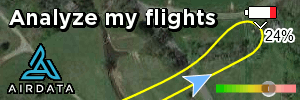In various posts regarding battery health, etc., I have seen pictures of cell voltage deviation tables from AirData. It appears that AirData calculates a deviation as the difference between the voltage of the two cells that are the lowest of all cells. So for a MP1 battery, they ignore the cell with the highest voltage of the three, and then subtract the voltage values of the remaining two cells. Likewise for an MP2 battery, they ignore the top two cells, and then use the difference in the remaining two cells with the lower voltage.
This algorithm seems illogical to ignore the difference between the cell with the highest voltage and the cell with the lowest voltage as the an expression of voltage deviation.
Either I’ve got AirData wrong, or I failed to understand the meaning of a voltage deviation.
Can any of you more knowledgeable people out there please give me some guidance about this topic?
Best wishes, and have a nice flight!
This algorithm seems illogical to ignore the difference between the cell with the highest voltage and the cell with the lowest voltage as the an expression of voltage deviation.
Either I’ve got AirData wrong, or I failed to understand the meaning of a voltage deviation.
Can any of you more knowledgeable people out there please give me some guidance about this topic?
Best wishes, and have a nice flight!











